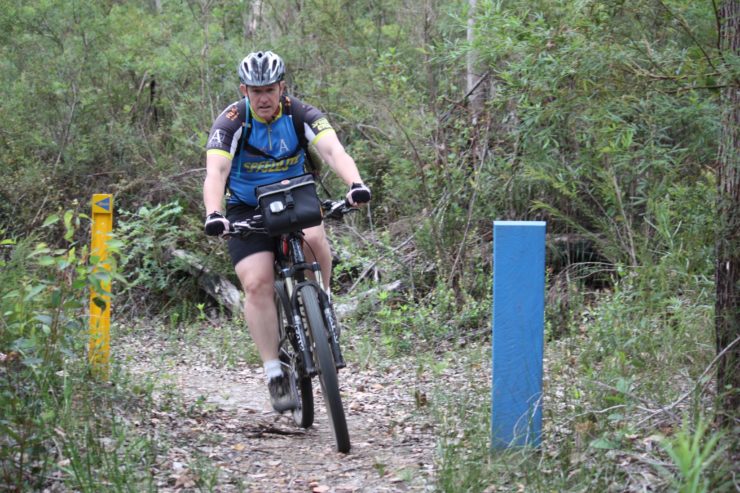Mountain Biking Skills for Beginners

Mountain Biking Skills for Beginners
Posted on
The need to know basics
Mountain biking is an energetic activity. It requires you to constantly shift your weight forward, rear and side-to-side. As the terrain shifts or obstacles are encountered, it’s up to you to keep the bike upright. Here are some beginners tips on how to do that:
Skills
Braking
It’s intuitive to lock up the brakes when we’re in a dangerous or confusing situation. We do it on our road bikes, in our cars, and you will do it automatically on a mountain bike. Locking up the brakes and skidding is almost always the first stage of a crash scenario.
Your bike has two brakes, a front and a rear. You need them both. By “feathering” your brakes before you get to tight corners, or during sustained downhills you won’t lock up your brakes and drag your wheels through every turn or all the way down a hill. Often times the tendency is to exclusively use your back brake, but the front brake provides excellent control and stopping power when used properly.
Try to brake before obstacles, not in the middle of them as the bike will “stand up” and stop turning. Evaluate an obstacle before you reach it, then once you commit, let go of the brakes and roll on through until you’re clear. Brake again on the other side if you need to.
Shifting
Your bike has gears, use them. Many times when we’re learning how to ride a bike off road, we focus so much on keeping the bike upright that we forget about making it easy to pedal.
When you encounter an uphill section, shift your bike into a ‘low gear.’ That means the chain should be on the biggest cog on the rear wheel. This is going to allow you turn the cranks more easily. Your legs will be spinning faster than the bike is rolling forward but you’ll be able to make it up the climb without having to stop for a rest.
Shifting your gears is all about timing. The better you get at shifting, the more efficient you’ll be on the trail. Don’t be afraid to try out different gears as it will take a while to figure out the combinations that work best for you.
By the way – You have to be pedalling to shift properly, there’s a sweet spot of power from your legs that will help shift the bike smoothly without jamming the gears.
Body Positioning
‘Ready’ position
This should be your default position on the bike when tackling anything moderately technical. Stand with your pedals level, elbows bent and weight centred over the bike. You need to remain fluid and relaxed; no death-grip on the bars! This go-to position allows the bike to move around underneath you and leaves you able to tackle the terrain ahead.
Climbing
You need traction but also good steering to get up steep hills. For traction you need your weight on the back tyre, for steering you need it on the front. The compromise is to remain seated but move to the nose of the saddle, then drop your shoulders low and as far forwards as possible, tuck in your elbows, pull down and back on the bars as you pedal. If you feel the rear tyre spinning then shift your body weight slightly backwards to keep enough traction on the back wheel.
Descending
When you go downhill on rough trails you want to use arms and legs as shock absorbers. Stand up on the pedals, keep your body low, arms and legs flexed, and shift your hips backwards so they’re above and behind the saddle. This lets you roll over the bumps easily – but keep your pedals level so you take the force equally between your feet.
If you want to improve stability and take the strain off your arms and upper body, make sure you roll downhill with your pedals level with each other, but actually have your heels lower than your toes. This means that when you brake, or hit a bump, you can absorb the force of your body pushing forwards using your legs, not arms and handlebars. It’s the key to remaining stable, and never flying over the bars when you stop in a hurry.
Cornering
Bikes corner best when you lean them over, but with a mountain bike you still want to keep your weight over the tyres so they stay gripped to the trails.
This means leaning the bike underneath you and opening your knees up so you can stay more upright. Drop the outside foot so you can push all your weight down through it – this keeps the weight even lower down and increases stability.
Bonus Tips:
1) Relax.
A tense body magnifies all of the bumps on the trail and bounces you around. Relax your arms, knees, face— everything. Remember this is meant to be fun!
2) Use your natural suspension
Your arms and legs are your best suspension. They should be bent at all times and moving up and down to absorb the bumps and dips of roots, ruts and rocks. Avoid muscle fatigue by loosening your handlebar death grip and keeping your arms in a position similar to doing a push-up (elbows out and bent).
So there you go, it’s as simple as Braking. Shifting. Balance.
Congratulations! You’re now a mountain biker.



